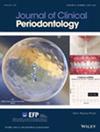Early Placement of Patient-Specific One-Piece Drill-Free Fully Digital Designed Dental Implants: A Feasibility Study
Abstract
Aim
CBCT and CAD/CAM technologies have allowed the development of patient-specific implants requiring no drilling. This prospective study evaluated the safety and effectiveness of a novel, drill-free, one-piece root-analogue implant designed using a digital workflow and manufactured additively.
Materials and Methods
Patients with non-restorable maxillary anterior or premolar teeth requiring extraction and implant placement were included. Implant design was based on pre-extraction cone-beam computed tomography (CBCT) and optical impressions of the target tooth, adjacent teeth and opposing dentition, and post-extraction scanning of the extracted tooth. Within 14 days post extraction, the implant was designed, manufactured and placed into the alveolar socket, and a temporary crown was installed out of occlusion. The final crown was installed after 3 months. Clinical parameters, including plaque index, gingival index, bleeding on probing, suppuration, peri-implant mucosal margin position, probing depth, probing depth relative to the implant platform and keratinised tissue, were collected at 3, 6, 9, 12 and 24 months post loading. Radiographic measurements as well as patient- and clinician-reported outcomes were also assessed.
Results
The study cohort comprised 12 patients. The cumulative implant survival and success rates reached 100% and 90%, respectively. Clinical and radiographic parameters consistently indicated healthy peri-implant tissues. Patient-reported outcomes demonstrated high satisfaction and minimal discomfort. Visual analogue scale (VAS) scores for overall satisfaction remained high, with a median of 10 at final restoration delivery (95% CI: 10.00–10.00) and at the 24-month follow-up (95% CI: 9.70–10.01).
Conclusion
These patient-specific, root-analogue implants demonstrated both safety and effectiveness, along with high patient satisfaction rates up to 24 months post loading.


 求助内容:
求助内容: 应助结果提醒方式:
应助结果提醒方式:


